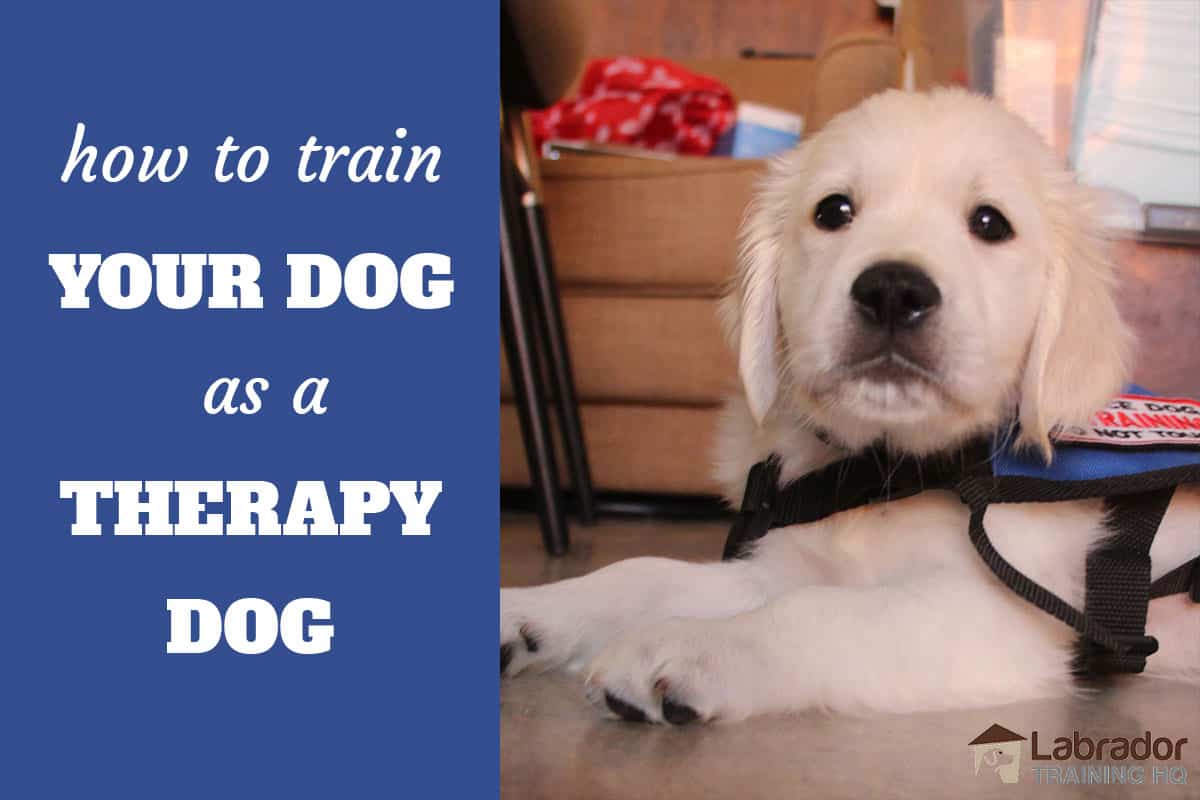Training a therapy dog typically takes around 6 months to 1 year, depending on their individual progress. Training a therapy dog is a rewarding process that requires time, patience, and dedication from both the handler and the dog.
The timeline for training a therapy dog can vary based on the dog’s temperament, breed, and previous training experiences. Dogs must undergo basic obedience training before starting therapy dog-specific training, which includes socialization, exposure to different environments, and mastering specific tasks.
It is essential to work with a qualified trainer or organization to ensure that the dog is properly trained and prepared for their role as a therapy dog. Despite the time commitment, the bond formed between the therapy dog and their handler through training is invaluable and greatly benefits those they will ultimately serve.

Credit: www.akc.org
The Role Of Training In Therapy Dog Preparation
Preparing a therapy dog takes time and dedication. The training length varies from dog to dog but typically ranges from several months to a year. Consistent training and positive reinforcement are essential for successful therapy dog preparation. The process involves obedience training, socialization, and specific therapy dog tasks.
| The Role of Training in Therapy Dog Preparation: |
| Therapy dogs require time investment for training to reach crucial milestones. |
| It’s important to realize that training a therapy dog is a commitment. |
| Dogs need to grasp tasks like basic obedience and socialization first. |

Credit: www.labradortraininghq.com
Understanding The Basics Of Therapy Dog Training
Training a therapy dog requires time and commitment. The duration of the training process can vary depending on various factors.
The initial assessment of the dog is crucial to determine its suitability for therapy work. Evaluating the dog’s temperament, social skills, and obedience level is essential to ensure the safety of the dog and those it interacts with. This assessment helps in identifying any behavior issues that need to be addressed before proceeding with therapy dog training.
Foundation training principles form the basis of therapy dog training. These principles include teaching basic commands like sit, stay, come, and leave. Additionally, positive reinforcement techniques are used to reward desired behaviors and build a strong bond between the handler and the dog.
Consistency and patience are key when training a therapy dog. Regular training sessions, providing mental stimulation, and exposing the dog to various environments are essential to improve their confidence and adaptability.
Overall, the process of training a therapy dog can take several months or more, depending on the individual dog’s temperament, previous training, and the handler’s dedication. With proper training and guidance, therapy dogs can make a positive impact on the lives of those they assist.
Factors Affecting Training Duration
Factors affecting the training duration of a therapy dog include the dog’s temperament and breed, as well as the trainer’s experience and methods. Each dog is unique, and some breeds may require more time and effort to train than others. A calm and obedient temperament can facilitate faster progress in training. The trainer’s experience and expertise play a crucial role in determining the training timeline, as they can employ effective methods suited to the individual dog’s needs.
Additionally, the training methods employed can vary, with some trainers utilizing positive reinforcement techniques while others may opt for more traditional methods. By taking these factors into consideration and tailoring the training approach to the specific dog, the training duration can be optimized, resulting in a well-trained therapy dog.
Training Timeline For Therapy Dogs
Training a therapy dog varies depending on several factors, including the dog’s personality, age, and previous training. Typically, it takes about 1-2 years to fully train a therapy dog, encompassing basic obedience, specialized tasks, and exposure to different environments. The process requires consistency, patience, and positive reinforcement techniques to ensure the dog is well-prepared for its role.
| Puppy to Adolescent Training | Specialized Therapy Dog Training |
| During the early stages, focus on basic obedience commands with positive reinforcement. | Specialized therapy training involves role-playing various therapy scenarios with distractions. |
| As the dog grows, introduce therapy-specific skills like calming techniques and socialization. | Training duration varies based on the dog’s individual progress and learning pace. |
| Transition from puppy to adolescent training can take around 6-12 months. | Therapy dog certification typically requires passing a specialized evaluation test. |
| Consistency, patience, and positive reinforcement play key roles in successful training. | Professional guidance and support can help streamline the therapy dog training process. |
Assessment And Evaluation Process
Training a therapy dog involves a customized plan addressing individual needs. After the initial assessment, behavioral progress is constantly monitored. Handlers’ interactions are observed to ensure proper integration. Regular evaluations are crucial for tracking development. Consistent training and positive reinforcement accelerate learning. Adaptations are made based on the dog’s responses.
The duration can vary depending on the dog’s breed, age, and existing skills. Consistency and patience are key during the evaluation phases. The goal is to ensure each therapy dog reaches the required standards before official certification. Adhering to structured training contributes to a successful therapy dog program.
Challenges And Solutions In Training Therapy Dogs
Training a therapy dog can take anywhere from six months to two years, depending on the dog’s breed, age, and previous training. Behavioral obstacles such as fear, aggression, or separation anxiety may require a professional trainer’s assistance. To overcome training plateaus, it’s crucial to incorporate variety and consistency into the training routine.
Consistent positive reinforcement and patience are key elements in successful therapy dog training. Establishing a strong bond and trust between the dog and the handler will contribute to the overall success of the training process.
The Impact Of Training On The Dog-handler Relationship
Training plays a crucial role in enhancing the dog-handler relationship. When it comes to therapy dogs, the time required for training can vary depending on the dog’s temperament, breed, and previous experience. It is important to invest adequate time and effort to ensure a successful therapy dog training journey.
| Training a therapy dog enhances the relationship between dog and handler. |
| Building trust is crucial for effective training. |
| Establishing a strong connection through training activities. |
| Communication skills improve with consistent training. |
| Encouraging responsiveness leads to a bonded pair. |

Credit: esacare.com
Measuring Training Success
Training a therapy dog can take time, patience, and consistency. The duration of training can vary depending on the dog’s breed, temperament, and previous training experience. It is important to set clear training goals and track the dog’s progress in achieving them. The success of training can be measured by observing positive behavioral changes in the dog. This can include desired behaviors such as following commands, interacting appropriately with humans and other animals, and remaining calm in various situations.
Consistent training sessions, positive reinforcement, and rewarding good behavior can help accelerate the training process. However, it is important to note that training is an ongoing process even after the initial goals are achieved. Regular practice, reinforcement of learned behaviors, and continued socialization can help maintain and improve the dog’s therapy skills.
Frequently Asked Questions
Is It Hard To Train A Dog To Be A Therapy Dog?
Training a dog to be a therapy dog can be challenging but rewarding with consistent training.
At What Age Do You Start Training A Therapy Dog?
Therapy dogs can start training as early as 6 months old. Starting training at a young age helps them develop good behaviors and social skills.
How Long Does It Take To Train An Emotional Support Dog?
Training an emotional support dog typically takes 6 months to 2 years, based on the dog’s temperament, behavior, and training methods used. Consistent, daily training sessions and positive reinforcement are key to success.
Is It Too Late To Make My Dog A Therapy Dog?
It’s never too late to make your dog a therapy dog. Training and certification are available for dogs of all ages.
Conclusion
Training a therapy dog requires patience and dedication. Consistent practice and positive reinforcement go a long way. Remember, each dog is unique, so the time it takes may vary. Stay committed to the process, and you’ll have a well-trained therapy dog by your side in no time.
Happy training!

Hello, I’m Ethan Mitchell. My passion is dog training and behavior enthusiasts. With years of experience working with various breeds, my goal at Dog Advisor Pro is to help dog owners build strong, loving relationships with their furry friends through effective training techniques. Understanding a dog’s behavior is the key to harmonious companionship. I am dedicated to sharing practical training tips that improve the lives of dogs and their owners.



Hi there,
My name is Mike from Monkey Digital,
Allow me to present to you a lifetime revenue opportunity of 35%
That’s right, you can earn 35% of every order made by your affiliate for life.
Simply register with us, generate your affiliate links, and incorporate them on your website, and you are done. It takes only 5 minutes to set up everything, and the payouts are sent each month.
Click here to enroll with us today:
https://www.monkeydigital.org/affiliate-dashboard/
Think about it,
Every website owner requires the use of search engine optimization (SEO) for their website. This endeavor holds significant potential for both parties involved.
Thanks and regards
Mike Black
Monkey Digital